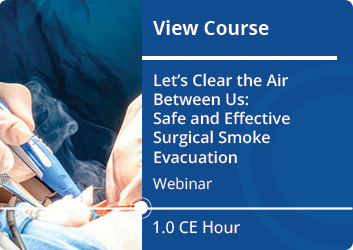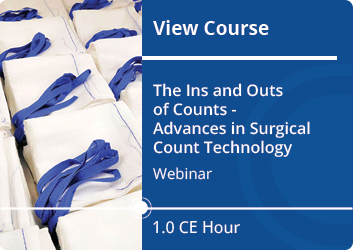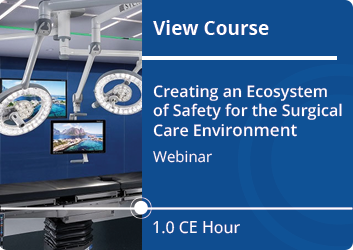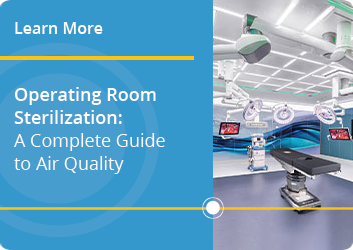Knowledge Center
February 19, 2024
Safety in the Operating Room
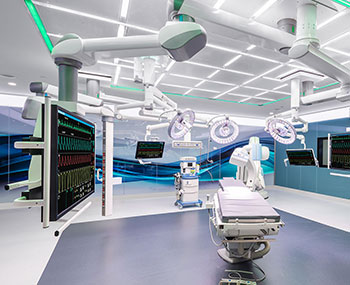
The surgical care environment contains many elements that must be optimized to deliver safe patient care and create a safe place of employment. Failure to account for certain aspects in the design of the perioperative environment may result in decreased efficiency, adverse effects on the staff, compromised cybersecurity, or negative patient outcomes. An integrated environment of care must be established to ensure a safe clinical environment. To ensure the highest quality environment for patients and staff, the design of the surgical suite must address such elements as air quality, equipment, and room layout.
Importance of Operating Room Safety
The rapid advancement of surgical technologies, including the growth of minimally invasive surgery, robotics, and advanced imaging equipment, is causing many hospitals to redesign their surgical suites to accommodate new equipment. Building a new operating room (OR) can cost $1 million to $3 million per surgical suite1, so institutions must involve rigorous interdisciplinary planning before investing.
Creating and maintaining an environment of care in the surgical suite aims to ensure that hospitals and surgery centers allow every patient to receive quality care without undue risk. This is achieved using evidence-based design to choose the right systems, equipment, and complementary products and accessories. These solutions allow nurses to focus on what they do best: care for patients.
What are safety precautions in the operating room?
When constructing or renovating a surgical suite, rigorous attention to evidence-based design ensures that the needs of patients, staff, and other stakeholders are considered. A well-designed surgical suite enhances patient safety, reduces patient and family stress, improves patient outcomes, reduces staff stress and fatigue, improves staff effectiveness, and contributes to overall healthcare quality.2
Patient’s Safety in the Operating Room
In patient-centered care, the patient’s health needs and desired health outcomes drive all healthcare decisions and quality measurements. In the surgical suite, patient outcomes and experiences are enhanced by adherence to best practices and carefully selecting systems, surfaces, and equipment that promote patient safety. This includes, but is not limited to, the following systems, equipment, and best practices:
- Incorporation of evidence-based design concepts for airflow and purification, as well as surface materials that are durable, nonporous, and easy to clean;
- Integration of OR information systems that allow for seamless workflow and communication between devices, including sharing of images and video, as well as heightened cybersecurity protection;
- Incorporation of lighting systems that promote optimal surgical visualization, do not obstruct airflow above the patient, are easy to maneuver, and resist drift;
- Selection of surgical tables that provide articulation and safe positioning for different case types (e.g., extreme angles, steep Trendelenburg, very low heights), as well as tables and accessories that can safely accommodate patients of all sizes (e.g., sleds, bed extenders, and bariatric tables and stirrups)
- Ensuring that, if VELCRO® is present, it is in good condition; minimizing the use of VELCRO® when possible3
- Choosing equipment with minimal crevices to prevent the buildup of contaminants;3
- Incorporation of tables designed for easy-to-clean maintenance with features such as accordion-style coverings over the base column to prevent both accumulations of contaminants and cross-contamination4
- Use of various types of padding and active pressure-reducing surfaces for patient protection (e.g., sacral pads, memory foam mattresses, padding for bony prominences, non-slip pads for patients in Trendelenburg position)
- Selection of active warming systems for maintenance of normothermia;
- Application of best practices for cleaning, disinfection, sterilization, and sterile techniques that keep surgical site infections to a minimum;
- Use of fast, easy, and reliable adjunctive technologies that minimize the incidence of retained surgical items
- Use of a unidirectional ultraclean air delivery system (e.g., laminar airflow), which reduces the risk of surgical site contamination as well as decreases the risk of back table contamination by providing high-efficiency particulate air filtration;5
- Use of ultraviolet light systems that reduce multidrug-resistant organisms (MDRO) on surfaces in patient rooms, reduce MDRO transmission between patients, and reduce surgical site infections;6
- Incorporation of smoke evacuation in the operating room increases visibility for the surgeon and staff, reduces the inhalation of harmful toxins present in surgical smoke, reduces the likelihood of port site metastasis, and reduces exposure to carbon monoxide.7
- Employment of methods to reduce patient anxiety in the operating room through preoperative music therapy, ample patient education, humor, and relaxation techniques such as jaw and body relaxation.8
- Applying the appropriate patient positioning in the operating room during surgeries.
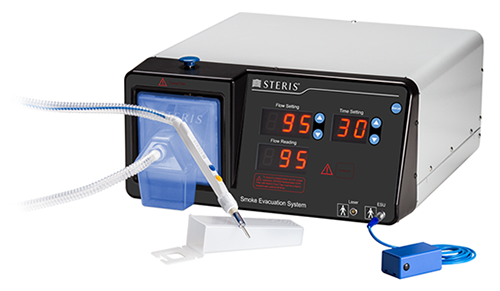
Discover how the STERIS Smoke Evacuation System can help protect your surgical staff and patients from the dangers of surgical smoke in the operating room (OR). The STERIS smoke evacuator has improved technology and delivers a highly effective method of collecting and filtering smoke produced during open or laparoscopic procedures.
Staff’s Safety in the Operating Room
Today’s hospitals are not just patient-centered; they are “human-centered” institutions where patient safety is intertwined with the health of everyone in the room.1 An optimized physical environment is essential in making hospitals safer, more healing, and better workplaces.
According to a literature review conducted by Ulrich et al., reducing staff stress by ergonomic interventions and carefully considering other issues such as air quality, noise, and light can significantly impact staff health. In addition, attention to the needs of personnel communicates to staff members that maintaining their health and safety is an important goal for the organization.2
Maintaining a safe environment of care in the surgical suite also requires attention to staffing numbers, staff training, and availability of appropriate staff and equipment to ensure safe patient handling and movement.
Minimizing Surgical Errors
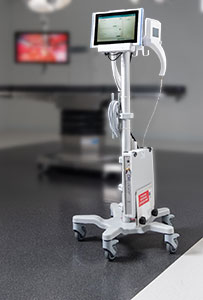
Performing preoperative verification processes and implementing a surgical safety checklist are crucial to maintaining a safe and well-prepped surgical site. The surgical safety checklist is based on the global implementation of the WHO Surgical Safety Checklist,18 a 19-item tool created by WHO in association with the Harvard School of Public Health. The surgical team should review their list before induction of anesthesia, skin incision, and moving the patient out of the operating room.
Utilizing advanced technology for surgical precision and accuracy can enhance patient safety and reduce time spent preventing human errors like retained surgical items.
Learn how ORLocate™ Surgical Counting and Detection System helps to track and manage surgical gauze and sponges, helping to reduce costs associated with retained surgical items.
Preventing Surgical Site Infections
It has been estimated that, of the more than 290,000 incidences of surgical site infection (SSI) annually, more than 13,000 people die each year due to infections acquired during surgical procedures. One estimate put the cost to hospitals per SSI at $25,546. In aggregate, this amounts to $7.4 billion in additional healthcare costs every year. In addition to the quality of care implications, the added costs of treating SSIs are not reimbursed for Medicare patients, placing this financial burden on hospitals.10
Studies have found a strong connection between contamination in the air during surgery and SSI rates10. Evidence from many studies confirms that hospital air quality and ventilation play decisive roles in affecting air concentrations of pathogenic microorganisms and, therefore, significantly affect infection rates.2 Instrument cleaning, sterilization, disinfection, hand hygiene, the use of sterile technique, wearing of surgical attire, and the selection of nonporous surfaces in the operating room also contribute to SSI prevention.
Learn more about CLEANSUITE® Operating Room Ceiling System
- Improves OR air quality by 1,000x that of traditional site-built, laminar-flow ceiling systems that conform to US FED STD 209E CLASS 100,000/ISO8
Potential risks of an unsafe surgical environment
Failure to create a safe environment of care can have negative consequences for patients, staff, and the healthcare system as a whole, including surgical site infections, inefficiencies, staff injuries and stress, cybersecurity issues, and compromised patient satisfaction, safety, and outcomes.
Compromised Patient Satisfaction and Outcomes
In addition to surgical site infections, failure to maintain a safe environment of care can have other adverse outcomes for patients, staff, and the health care system in general, including the following:
- Retained surgical instruments;
- Injuries due to improper patient positioning;
- Pressure Injuries
- Delays and patient anxiety due to missing equipment or information;
- Hypothermia
- Reduced scores for the hospital on Medicare’s Hospital Consumer Assessment of Health Care Providers and Systems (HCAHPS), administered by the federal Centers for Medicare and Medicaid Services (CMS)
- Increased patient anxiety in the operating room due to noise, such as alarm sounds and the clanging of instruments unpacked from their carriers.8
Staff Injury and Stress
Insufficient attention to the safety of the work environment also has the potential to create adverse outcomes for surgeons and perioperative staff, including:
- Work-related symptoms caused by poor lighting, excessive noise, and prolonged static positioning
- Injuries caused by the need to move patients and equipment without the appropriate assistive devices
- Burnout caused by inefficient scheduling, communication, and task management
- Illness related to exposure to surgical smoke
Inefficiency
Due to advanced diagnostic and imaging technology availability, ORs have become increasingly congested and complex. A modern OR often contains booms, surgical tables, surgical lighting, and room lighting positioned throughout the room, multiple surgical displays, communication system monitors, camera systems, recording devices, and medical printers.
Without an OR Integration system, surgical teams must move around the surgical suite to perform a variety of tasks, including checking a computer for patient information, writing this information on a whiteboard, moving to the wall to control lighting, and stepping into the surgical field to display or change the video they are viewing.12 The movement and time required to complete these tasks slow a procedure down and can detract attention from the patient. Operating rooms without an integration system also require more machines brought forward and pushed back with each case. An integration system offers a center console, eliminating the need for many machines in a traditional operating room. Without this system, the additional cords and machines cause tripping hazards, inefficient staff movements, the risk of pulling out wires, the need for additional personnel, and the risk of damaging equipment.13
This inefficiency can extend beyond the operating room. An integration system offers the ability to conference in other operating theaters for expert opinion and consultation; without this, care can be delayed or compromised, and job training can be slowed.13 Integrated systems can also reach other hospital areas, including pathology, laboratory, and radiology. Without this capability, there may be a delay in the surgeon receiving pathology results, which could lead to additional surgeries, or the patient may need additional radiology scans in the operating room.13 Some integrated systems can also save images captured during the procedure and seamlessly incorporate them into the patient’s chart, saving time for the staff.14
Cybersecurity Issues
Cybersecurity protects electronic information and infrastructure from unauthorized access, use, and disclosure. The three main objectives of cybersecurity are preserving the confidentiality, integrity, and availability of information.15 When cybersecurity is compromised, hospital operations are disrupted, and patient privacy may be breached.
Contributors
Lena Fogle BSN, RN, CNOR
Senior Director Global Clinical Solutions, STERIS Healthcare
Related Videos
ORLocate™ Surgical Counting and Detection System
CLEANSUITE® Operating Room Ceiling System
CleanRoom Innovations for Operating Room
Article References
1 Rosen E. Operating rooms go under the knife. New York Times. May 5, 2021.
2 Ulrich R, Quan X, Zimring C, Joseph A, Choudhary R. The role of the physical environment in the hospital of the 21st century: a once-in-a-lifetime opportunity. https://www.healthdesign.org/system/files/Ulrich_Role%20of%20Physical_2004.pdf. Published September 2004. Accessed November 22, 2021.
3 The Joint Commission. Environmental Infection Prevention: Guidance for continuously maintaining a safe patient care and survey-ready environment. Joint Commission website. https://store.jcrinc.com/assets/1/7/nexclean_environinfectionprevention_(002).pdf. Published 2018. Accessed February 1, 2022.
4 STERIS. Control every move. See every detail. The SurgiGraphic 6000 image guided surgical table. STERIS Web site. https://www.steris-healthcare.com/medias/docs/0cd0df2dde3ce985633160fac10f85ebab18b84a.pdf. Published 2005. Accessed February 2, 2022.
5 Association of periOperative Registered Nurses. Guideline for sterile technique. In: Guidelines for Perioperative Practice. Denver, CO: AORN; 2022:1019-1058.
6 Association of periOperative Registered Nurses. Guideline for environmental cleaning. In: Guidelines for Perioperative Practice. Denver, CO: AORN; 2022:183-212.
7 Association of periOperative Registered Nurses. Guideline for surgical smoke safety. In: Guidelines for Perioperative Practice. Denver, CO: AORN; 2022:1109-1154.
8 Bailey, L. Strategies for decreasing patient anxiety in the perioperative setting. AORN J. 2010;92(4):445-460.
9 What is patient-centered care? NEJM Catalyst Web site. https://catalyst.nejm.org/doi/full/10.1056/CAT.17.0559. Published 2017. Accessed December 4, 2021.
10 Wagner JA, Schreiber KJ, Cohen R. Using cleanroom technology: improving operating room contamination control. ASHRAE Journal. February 2014:18-22,24,26-27.
11 Stucky CH, Cromwell KD, Voss RK, et al. Surgeon symptoms, strain, and selections: Systematic review and meta-analysis of surgical ergonomics. Ann Med Surg (Lond). 2018;27:1-8.
12 STERIS. Integrated operating rooms. What is an integrated operating room? STERIS Web site. https://www.steris.com/healthcare/knowledge-center/surgical-equipment/integrated-operating-rooms. Published November 1, 2021. Accessed February 1, 2022.
13 Kumar S, Kant S, Siddharth V. Integration in operation theater: Need of the hour. Int J Res Foundation Hosp Healthc. 2015;3(2):123-128.
14 STERIS. OR integration for case in crisis. STERIS Web site. https://ww1.steris.com/onbDocs/V474/0/3568425.pdf. Published September 2020. Accessed February 1, 2022.
15 Healthcare Information and Management Systems Society. 2020 HIMSS cybersecurity survey. https://www.himss.org/sites/hde/files/media/file/2020/11/16/2020_himss_cybersecurity_survey_final.pdf. Published 2020. Accessed November 26, 2021.
16 Association of periOperative Registered Nurses. Guideline for design and maintenance of the surgical suite. In: Guidelines for Perioperative Practice. Denver, CO: AORN; 2022:89-118.
17 STERIS. CLEANSUITE operating room ceiling system. STERIS Web site. https://www.steris.com/healthcare/products/or-environment/cleansuite-ceiling-system. Published 2022. Accessed February 1, 2022.

